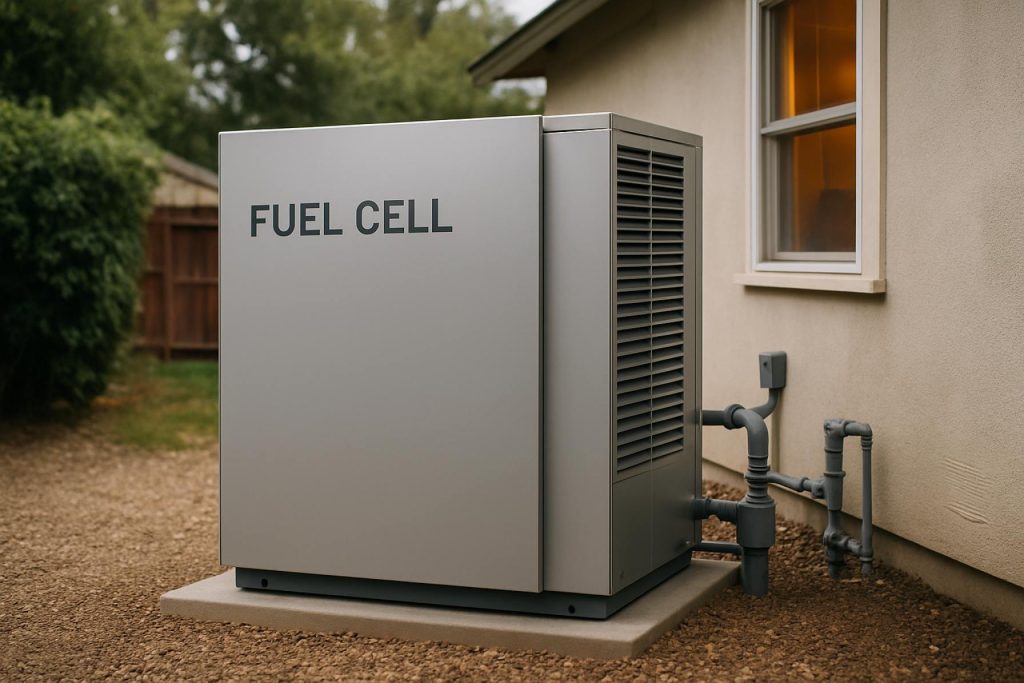
- Electricity outages are increasing as severe weather and aging power grids threaten reliability, especially in Western Pennsylvania and the PJM Interconnection region.
- The WATT HOME solid oxide fuel cell uses natural gas to generate electricity through a noiseless, combustion-free electrochemical process, reducing carbon emissions and local air pollution.
- Smaller and more efficient than traditional backup generators, the unit can be installed in basements, monitored by utilities, and integrated with solar panels or batteries for enhanced energy resilience.
- Utilities like Peoples Natural Gas are piloting these systems, signaling wider adoption for households seeking reliable backup power during storms and blackouts.
- This innovative technology offers an accessible, low-impact solution for families to ensure electricity supply and peace of mind in an era of climate uncertainty.
The gentle hum of household life can disappear in an instant as the power blinks out—often, just as another storm lashes the neighborhood. Across Western Pennsylvania and beyond, blackout anxiety is rising. Average Americans now face almost six hours of electricity interruptions each year, according to the latest federal data. As severe weather intensifies and the nation’s sprawling grid ages, the risk of outages creeps ever higher.
Yet, on an ordinary Pittsburgh morning, a new hope has been quietly installed: the cutting-edge WATT HOME solid oxide fuel cell, seamlessly integrated into a family’s existing natural gas connection. This system doesn’t burn fuel like a smoky generator; instead, it draws on science rarely seen in neighborhoods, quietly converting natural gas into electricity with a high-tech electrochemical process—delivering steady power without flames, noise, or the signature whiff of diesel.
Modern Engineering Meets Everyday Resilience
Developed by local manufacturer WATT Fuel Cell, this next-generation unit shapes itself to the realities of modern life. The design, barely the size of a couple stacked suitcases, can slip easily into a basement or utility room. It whispers along, producing efficient, reliable electricity during outages or grid instability, acting as the silent hero when the grid falters.
Unlike traditional backup generators that require messy refueling and roar to life with a cloud of exhaust, this elegantly engineered device simply taps into natural gas—already piped to more than half of U.S. households. Its electrochemical reaction produces electricity without open combustion, driving down carbon emissions and significantly reducing pollution, including harmful nitrogen oxides and particulates.
Why Backup Power Matters Now More Than Ever
The timing could not be better. Major regional power markets, such as PJM Interconnection, which serves more than 65 million people from Pennsylvania to Illinois, increasingly feel the strain from heatwaves, deep freezes, and an aging fleet of large power plants. As old coal and nuclear plants shutter, insurers and regulators alike have sounded the alarm about worsening grid reliability in the coming decade.
For homeowners in the Essential Utilities service area—one of the nation’s leading water and gas providers—the fuel cell’s launch signals a powerful shift. Peoples Natural Gas, the area’s largest natural gas utility, will soon pilot the system in company offices, setting the stage for a wider rollout.
Smaller Footprint, Greater Efficiency
The fuel cell’s physical footprint matches its environmental one. Because it avoids combustion, greenhouse gas emissions can be 30-50% lower than traditional generators, and it emits virtually no local air pollution. What’s more, its design allows home integration with solar panels or batteries, extending energy independence for years to come.
This isn’t just an engineering breakthrough—it’s an accessible solution for everyday people seeking peace of mind. Utilities can maintain and monitor these units, making backup power as effortless as flipping a switch.
The Bottom Line: The Future of Backup Power
As climate events increasingly threaten the grid’s reliability, innovations like WATT HOME’s fuel cell offer households a lifeline—cutting noise, pollution, and hassle, while keeping the essentials running when it matters most. With Pennsylvania’s abundant natural gas and the potential to collaborate with renewables, this small unit may scale quickly to reshape backup power far beyond the region.
Consumers will soon face a crucial choice: stick with aging generators and fragile wires, or embrace a locally built, quietly powerful way to keep the lights on—no matter what rolls in next.
Takeaway: The rise of resilient, low-impact backup power is here. For families wary of mounting blackout risks, the future might already be humming softly in a neighbor’s basement, waiting for the next storm.
This Silent Revolution Will Change How You Power Your Home: Everything You Need to Know About Solid Oxide Fuel Cells
Overview: Solid Oxide Fuel Cells Redefining Home Backup Power
In a world increasingly threatened by severe weather, aging infrastructure, and mounting power outages, the WATT HOME solid oxide fuel cell—a cutting-edge backup solution—emerges as a transformative technology. This article expands on the facts in the source piece, diving deep into the engineering, practical use cases, market trends, sustainability, and what this breakthrough means for your home.
—
Key Facts & New Insights You Need To Know
1. How Solid Oxide Fuel Cells Work: No Flames, Just Science
– Core Principle: Solid oxide fuel cells (SOFCs) electrochemically convert natural gas or hydrogen directly into electricity. Unlike traditional generators, there’s no combustion—resulting in quieter, more efficient, and cleaner operation.
– Efficiency: SOFCs typically achieve electrical efficiencies of 45–60%, compared to 20–40% for standard combustion-based generators ([Department of Energy](https://www.energy.gov)).
– Durability: These cells can run continuously for thousands of hours with low degradation, which means fewer maintenance intervals and better long-term reliability.
2. How-To: Installing and Operating a Fuel Cell System
Step-by-Step Homeowner Guide:
1. Site Assessment:
– Work with your utility or a licensed installer to identify an optimal spot (basement, garage, or utility room).
2. Connection:
– Tie into your home’s existing natural gas line. The WATT HOME model is designed for compatibility with standard residential gas pressures.
3. Integration:
– Unit is wired into your home’s critical loads circuit (refrigerator, lighting, furnace fan, etc.).
4. Optional Add-ons:
– Can pair with solar arrays and batteries for expanded resilience and further decarbonization.
5. Remote Monitoring:
– Many modern SOFCs, like those from WATT Fuel Cell, come with software allowing homeowners and utilities to monitor performance remotely.
3. Real-World Use Cases
– Suburban Homes: Seamlessly maintain power in blackouts without polluting the neighborhood or requiring noisy operation.
– Critical Infrastructure: Hospitals and water utilities can ensure clean, quiet backup without diesel dependency.
– Remote Locations: Off-grid cabins or rural areas can leverage local gas supply for year-round power.
4. Features, Specs & Pricing
– Physical Size: About 2–3 suitcase units stacked; fits most basements or utility rooms.
– Output: Varies—WATT HOME’s model can produce enough to power most essential home loads.
– Noise: Virtually silent; ideal for neighborhoods worried about noise ordinances.
– Emissions: Significantly lowered greenhouse gases and NOx; nearly eliminates SOx and particulates.
– Pricing (2024 estimate): Early models are projected around $12,000–$20,000 installed, before incentives. Prices may drop as manufacturing scales and with utility pilot programs.
5. Security & Sustainability
– Grid Independence: Provides resilient power during grid outages, storms, and cyber-op attacks.
– Environmental Advantages: When operated continuously, SOFCs can reduce carbon emissions by 30–50% compared to grid electricity in regions reliant on coal or oil.
– Hydrogen Ready: Many new units could be adapted to run on green hydrogen in the future as the supply becomes available, making this an investment in long-term sustainability ([IEA](https://www.iea.org)).
6. Reviews, Comparisons & Limitations
– Compared to Generators:
– SOFCs: Silent, no exhaust, lower emissions, higher efficiency, automatic operation.
– Traditional Generators: Noisy, frequent refueling, polluting, manual startup, higher maintenance.
– Compared to Home Batteries:
– SOFCs: Can provide days/weeks of power as long as gas is supplied.
– Home Batteries (like Tesla Powerwall): Limited by stored energy unless recharged via solar.
– Limitations: Upfront cost remains higher than basic generators (but can be offset by utility programs and incentives). Unit may need occasional servicing and is dependent on the continued supply of natural gas (or future hydrogen).
7. Market Forecasts & Industry Trends
– Growth: The global SOFC market is projected to grow at a CAGR of 12%–15% over the next five years ([MarketsandMarkets](https://www.marketsandmarkets.com)).
– Policy Support: Federal and state tax credits may become available, particularly in the wake of IRA (Inflation Reduction Act) clean energy incentives.
– Utility Integration: Forward-thinking utilities like Essential Utilities are investing in distributed power, seeing SOFCs as a tool to reduce grid stress and improve overall resilience.
8. Controversies & Limitations
– Natural Gas Dependency: While cleaner than diesel or gasoline, methane leakage in the gas supply chain remains a concern for environmental impact (see EPA studies).
– Cost Barriers: High initial pricing can put SOFCs out of immediate reach for many consumers, though prices should drop with mass adoption.
– Fuel Source Transition: Full decarbonization relies on the future transition to renewable methane or green hydrogen.
—
Most Pressing Questions from Readers—Answered
Q: Can the unit power my whole home?
A: Typically, the SOFC is sized for critical loads—refrigerator, lights, internet, and heating/cooling essentials. Larger models or multiple units may power entire homes.
Q: What if I lose natural gas service?
A: Like all gas appliances, a SOFC requires a steady fuel source. For maximum resilience, pair it with solar and battery systems.
Q: How much maintenance is required?
A: SOFCs generally need less frequent maintenance than combustion generators—mainly periodic inspections, air filter changes (if equipped), and software updates.
Q: How much will I save on my electric bill?
A: If run continuously, SOFCs can offset costly peak electricity or backup needs, but the main value is resilience, not direct cost savings—at least at current gas and electricity rates.
Q: Are incentives or rebates available?
A: Check state and federal programs aligned with clean distributed energy technologies—new rules may make SOFCs more affordable soon.
—
Actionable Recommendations & Quick Tips
– Assess Your Outage Risk: If you face frequent outages, a SOFC could deliver peace of mind and uninterrupted comfort.
– Check Utility Partnerships: Early adopters may benefit from utility pilots, rebates, or maintenance bundles.
– Pair With Solar/Batteries: For maximum independence, integrate your SOFC with solar panels or home energy storage.
– Monitor Evolving Incentives: As the market matures, subscribe to updates from manufacturers like WATT Fuel Cell and local utility websites for incentive news.
– Prioritize Safety: Always use qualified technicians for installation—fuel cell systems, though clean, use high temperatures and gas.
—
The Bottom Line
Solid oxide fuel cells like WATT HOME usher in a new era of backup power: whisper-quiet, clean, and always ready. While initial costs remain a barrier for some, partnerships with utilities, evolving incentives, and the promise of future hydrogen compatibility make these units an exciting prospect for resilient, sustainable living. As blackout risks rise, investing in next-generation technology could be your smartest home upgrade yet.
For more on natural gas and utility innovations, visit these trusted industry leaders:
– WATT Fuel Cell
– Essential Utilities



